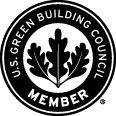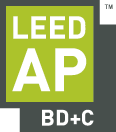Sustainable
Introduction:
A Sustainable or Green Building Design is defined as one that meets the needs of the present without compromising the ability of future generations to meet their own needs.
 LEED, which stands for Leadership in Energy and Environmental Design, is a U.S. Green Building Council program that establishes performance benchmarks for projects wishing to provide a measurable positive impact on a building’s performance, the wellbeing of the occupants, and the environment.
LEED, which stands for Leadership in Energy and Environmental Design, is a U.S. Green Building Council program that establishes performance benchmarks for projects wishing to provide a measurable positive impact on a building’s performance, the wellbeing of the occupants, and the environment.
 To better serve our clients, we at Magaddino Architecture have completed a rigorous course of study and testing given by the Green Building Certification Institute. We are proud to have earned a Certification as a LEED Accredited Professional with a specialization in Building Design and Construction.
To better serve our clients, we at Magaddino Architecture have completed a rigorous course of study and testing given by the Green Building Certification Institute. We are proud to have earned a Certification as a LEED Accredited Professional with a specialization in Building Design and Construction.
The more than 30 years of architectural design experience has made us very aware of how much of an impact we can have on the environment and the lives of the people who utilize the projects that we design. We have been challenged, and have met those challenges, in both new and renovated facilities, with designs that meet the demands make facilities that are accessible, secure, healthy, and productive while at the same time minimizing their impact on the environment. Only recently, with the advent of programs like LEED and Energy Star, has it become possible to quantify the degree of sustainability achieved on a given project.
It’s up to the individual client as to whether they want to register their project and achieve the required levels of performance needed for LEED certification. A LEED certification can be a great marketing point, but realistically, for most clients the aim will be to achieve a partial degree of Greening. This can be accomplished by developing strategies that incorporating some sustainable components, for example they may utilize reclaimed and/or regional building materials, or they may have energy efficient equipment such as tankless water heaters and ground source heat pump heating systems, or they may include resource conserving building components that contain a high percentage of renewable and recycled contents.
Building Green:
The LEED program encourages, supports, and certifies implementation of sustainable practices. Rather than depending on third party consultants, Joseph is able to offer the client a comprehensive design service that augments his over 30 years of architectural experience with his understanding of the intent, requirements and strategies of the LEED program. This comprehensive approach results in an integrated design that in turn produces the most efficient and therefore cost effective project possible.
What makes a Building Green?
A green building, also known as a sustainable building, is a structure that is designed, built, renovated, operated, or reused in an ecological and resource-efficient manner. Green buildings by their very nature protect occupant health, improve employee productivity and use resources more efficiently.
What are the economic benefits of Green Buildings?
Green buildings offer positive economic impacts in three ways:
- They lower the operating costs of the building over the life of the building.
- They increase the productivity of their occupants.
- They are eligible for Federal, State and industry incentives.
Many green building measures can be incorporated with minimal or zero increase in up-front costs when they are incorporated in the project during it’s conceptual design phase.
What are the principal elements of Green Building design?
Site Development
- Start by selecting a site well suited to take advantage of mass transit.
- Protect and retain existing landscaping and natural features. Select plants that have low water and pesticide needs, and generate minimum plant trimmings. Use compost and mulches. This will save water and time.
- Recycled content – paving materials, furnishings, and mulches help close the recycling loop.
Energy Efficiency
- Passive design strategies can dramatically affect building energy performance. These measures include building shape and orientation, passive solar design, and the use of natural lighting.
- Develop strategies to provide natural lighting. Studies have shown that it has a positive impact on productivity and well-being.
- Install high-efficiency lighting systems with advanced lighting controls. Include motion sensors tied to dimmable lighting controls. Task lighting reduces general overhead light levels.
- Use a properly sized and energy-efficient heat/cooling system in conjunction with a thermally efficient building shell. Maximize light colors for roofing and wall finish materials; install high R-value wall and ceiling insulation; and use minimal glass on east and west exposures.
- Minimize the electric loads from lighting, equipment, and appliances.
- Consider alternative energy sources such as photovoltaics and fuel cells that are now available in new products and applications. Renewable energy sources provide a great symbol of emerging technologies for the future.
- Computer modeling is an extremely useful tool in optimizing design of electrical and mechanical systems and the building shell.
Material Efficiency
- Use dimensional planning and other material efficiency strategies. These strategies reduce the amount of building materials needed and cut construction costs. For example, design rooms on 4-foot multiples to conform to standard-sized wallboard and plywood sheets.
- Reuse and recycle construction and demolition materials. For example, using inert demolition materials as a base course for a parking lot keeps materials out of landfills and costs less.
- Require plans for managing materials through deconstruction, demolition, and construction.
- Design with adequate space to facilitate recycling collection and to incorporate a solid waste management program that prevents waste generation.
Water Efficiency
- Design for dual plumbing to use recycled water for toilet flushing or a gray water system that recovers rainwater or other non-potable water for site irrigation.
- Minimize wastewater by using ultra low-flush toilets, low-flow showerheads, and other water conserving fixtures.
- Use recirculation systems for centralized hot water distribution.
- Install point-of-use hot water heating systems for more distant locations.
- Use a water budget approach that schedules irrigation using the California Irrigation Management Information System data for landscaping.
- Meter the landscape separately from buildings. Use micro-irrigation (which excludes sprinklers and high-pressure sprayers) to supply water in nonturf areas.
- Use state-of-the-art irrigation controllers and self-closing nozzles on hoses.
Occupant Health and Safety
- Recent studies reveal that buildings with good overall environmental quality can reduce the rate of respiratory disease, allergy, asthma, sick building symptoms, and enhance worker performance. The potential financial benefits of improving indoor environments exceed costs by a factor of 8 and 14.
- Choose construction materials and interior finish products with zero or low emissions to improve indoor air quality. Many building materials and cleaning/maintenance products emit toxic gases, such as volatile organic compounds (VOC) and formaldehyde. These gases can have a detrimental impact on occupants’ health and productivity.
- Provide adequate ventilation and a high-efficiency, in-duct filtration system. Heating and cooling systems that ensure adequate ventilation and proper filtration can have a dramatic and positive impact on indoor air quality.
- Prevent indoor microbial contamination through selection of materials resistant to microbial growth, provide effective drainage from the roof and surrounding landscape, install adequate ventilation in bathrooms, allow proper drainage of air-conditioning coils, and design other building systems to control humidity.
Building Operation and Maintenance
- Green building measures cannot achieve their goals unless they work as intended. Building commissioning includes testing and adjusting the mechanical, electrical, and plumbing systems to ensure that all equipment meets design criteria. It also includes instructing the staff on the operation and maintenance of equipment.
- Over time, building performance can be assured through measurement, adjustment, and upgrading. Proper maintenance ensures that a building continues to perform as designed and commissioned.